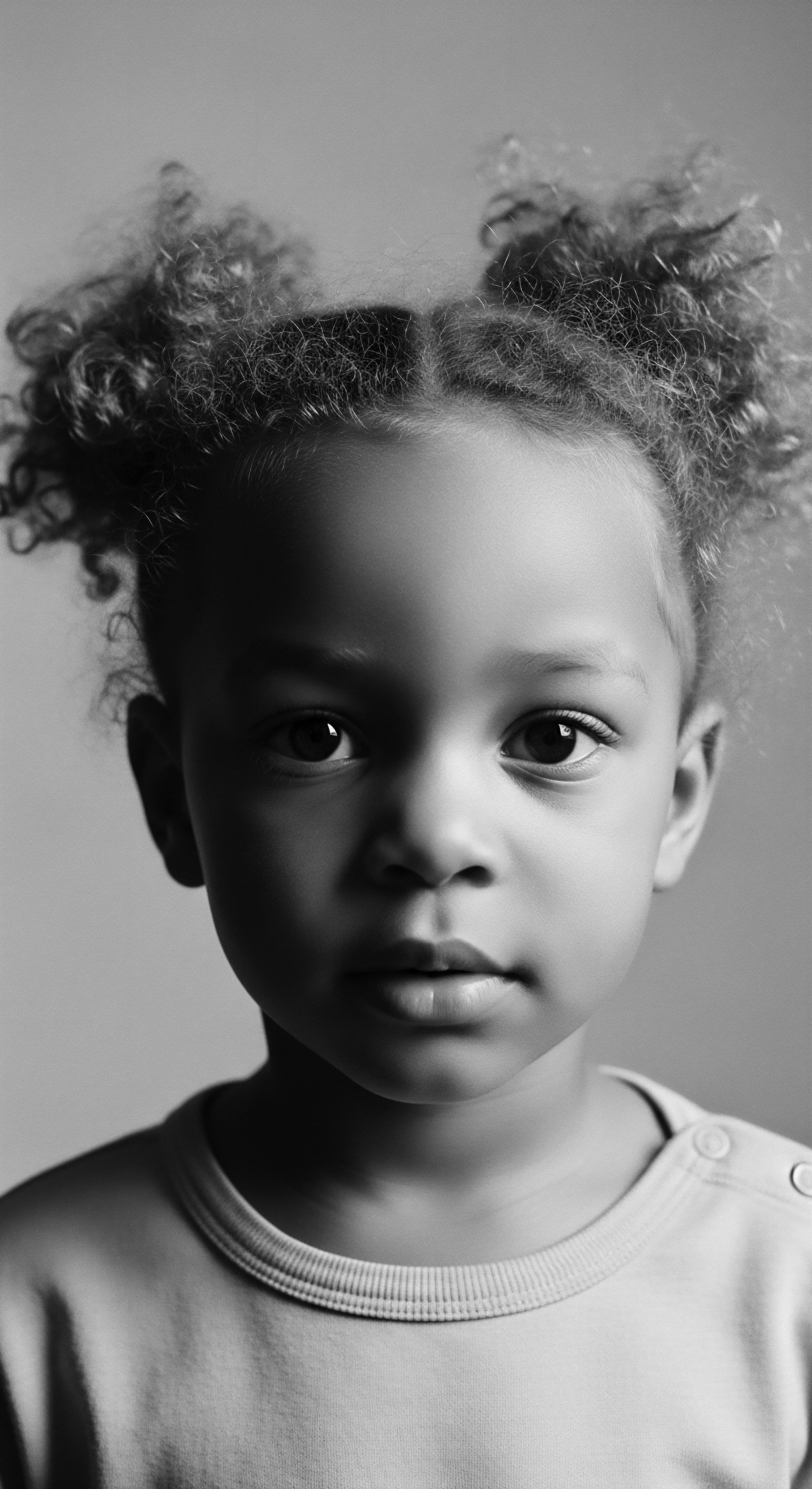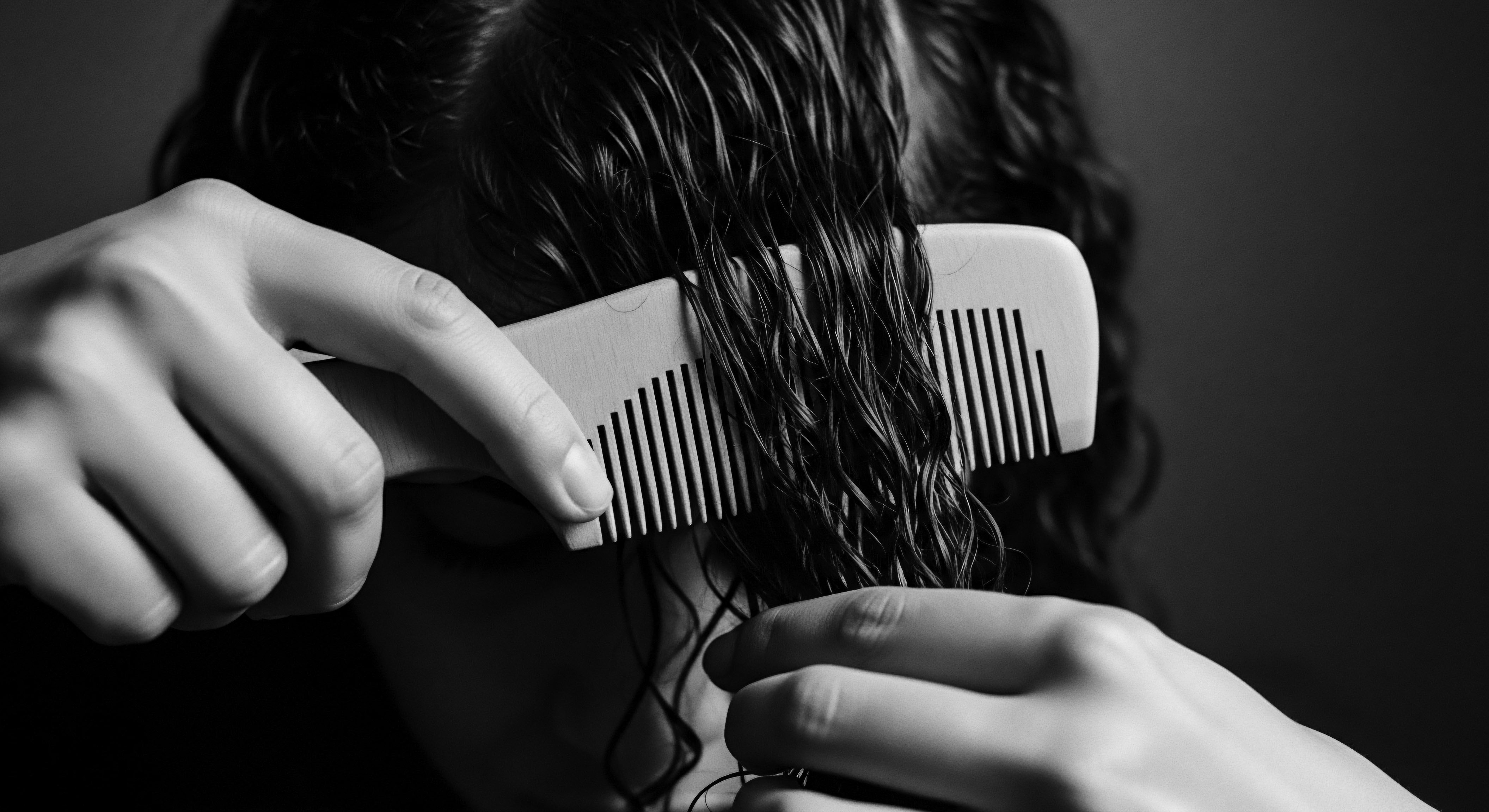
Fundamentals
The journey into understanding the Cortisol Hair Impact begins with recognizing hair, particularly textured hair, as a profound repository of ancestral wisdom and living experience. It is more than strands; it is a visible manifestation of our inner and outer worlds, capable of holding echoes of our well-being. To grasp the Cortisol Hair Impact is to appreciate how deeply our physiological responses intertwine with the very fibers that adorn our heads, a concept woven into the fabric of human history.
At its elemental core, cortisol is a naturally occurring steroid hormone, produced within the adrenal glands, playing a pivotal role in the body’s stress response. It is often referred to as the body’s “stress hormone,” yet its responsibilities extend far beyond moments of perceived threat. Cortisol helps regulate a multitude of physiological processes, including metabolism, immune function, and inflammatory responses. Its presence maintains a delicate balance, a rhythm of readiness and repose within our systems.
When life presents demands, cortisol levels rise to equip the body with the energy and focus needed to meet challenges. Once the challenge recedes, cortisol levels typically return to their baseline. This natural ebb and flow safeguards the body’s equilibrium.
Hair stands as a testament to journeys, subtly reflecting the body’s internal responses to the world’s rhythms.
The distinction lies in the concept of chronic stress. While acute, fleeting surges of cortisol serve a protective purpose, prolonged elevation of this hormone can disrupt the body’s intricate harmony. This sustained presence, this constant hum of cortisol, can leave its mark on various bodily systems, including the hair follicles. The hair follicle, a dynamic mini-organ nestled beneath the scalp, undergoes cycles of growth, rest, and shedding.
Each cycle is exquisitely sensitive to internal signals. When cortisol levels remain persistently elevated, this delicate equilibrium can be disturbed, altering the very conditions under which hair thrives.
The Cortisol Hair Impact, in its fundamental sense, therefore refers to the observable and measurable effects of chronic or prolonged stress, mediated by sustained cortisol exposure, upon the health, growth, and structural integrity of hair. This measurement is often achieved through analysis of Hair Cortisol Concentration (HCC), which provides a retrospective record of cortisol levels over weeks or months, as the hormone is incorporated into the growing hair shaft. Unlike blood or saliva tests that capture momentary cortisol levels, hair serves as a living archive, documenting the body’s long-term engagement with stress. Understanding this mechanism allows us to decipher narratives held within each strand, tales of resilience, challenge, and the body’s silent responses to life’s many currents.

The Hair’s Intrinsic Cycles and Stress
Hair growth proceeds through distinct phases, a cycle known to ancient healers and modern scientists alike. This progression, from active growth to resting and shedding, is a testament to the hair follicle’s inherent wisdom.
- Anagen ❉ This is the active growth phase, where cells in the hair root divide rapidly, adding to the hair shaft. Length of this phase dictates ultimate hair length.
- Catagen ❉ A transitional phase, signaling the end of active growth. The hair follicle shrinks, detaching from the dermal papilla.
- Telogen ❉ The resting phase, where the hair remains in the follicle but is not growing. A new hair typically begins the anagen phase, pushing the old hair out.
- Exogen ❉ The shedding phase, where the old hair falls out.
When stress becomes a persistent companion, the body’s innate wisdom can be disrupted. Elevated cortisol can prematurely push hair follicles from the active growth phase (anagen) into the resting and shedding phases (telogen and exogen). This leads to increased shedding, a condition known as Telogen Effluvium, where a noticeable number of hairs enter the resting phase simultaneously, leading to widespread thinning. For centuries, ancestral practices focused on nurturing the scalp and hair, perhaps intuitively countering the physiological effects of daily stressors, even without the modern understanding of hormones.

Intermediate
Moving beyond the elemental definition, an intermediate understanding of the Cortisol Hair Impact delves deeper into the mechanisms by which sustained physiological strain shapes the very fibers that crown us. This perspective necessitates an appreciation for hair not merely as an aesthetic feature, but as a biological record, echoing the systemic pressures encountered by the body. For textured hair traditions, this record holds particular resonance, intertwined as it is with narratives of cultural perseverance, societal expectations, and often, systemic strain. The meaning of the Cortisol Hair Impact, then, broadens to encompass not just the biological, but the psychosocial dimensions of well-being, particularly within communities whose hair has often been a site of both celebration and contestation.

Hair as a Chronicle of Physiological Response
The human hair strand, a remarkable bio-indicator, incorporates cortisol as it grows from the follicle, offering a unique retrospective window into an individual’s chronic stress exposure over time. Each centimeter of hair can represent approximately one month of growth, allowing researchers to measure Hair Cortisol Concentration (HCC) and reconstruct an individual’s cumulative physiological experience of stress across a span of several months. This objective measure distinguishes chronic, systemic stress from transient, daily fluctuations, which might only register in fleeting blood or saliva samples. The meaning of HCC deepens when we consider populations that historically endure disproportionate exposure to chronic stressors.
Consider the profound observations emerging from research into Black and mixed-race communities. The very experience of navigating societies often unequipped to appreciate diverse hair textures and cultural expressions places an unseen burden on individuals. This ongoing negotiation, often subtle yet persistent, contributes to cumulative stress.
The hair, an ancient keeper of stories, whispers truths about the body’s enduring spirit amidst strain.
A powerful instance of this is found in a study by Thome et al. (2020), which indicated that the mean HCC for pregnant Black participants was significantly greater than for pregnant White women in comparative published studies. This statistic, stark in its simplicity, speaks volumes about the pervasive environmental and systemic stressors that disproportionately affect Black women, even during periods of physiological change.
This is not merely a biological fact; it is a cultural indictment of the persistent inequities that manifest within the very biology of those most affected. The threads of hair, in this context, become silent witnesses to a lived reality.

The Cultural Weight of Hair and Stress
The significance of hair within Black and mixed-race communities extends far beyond simple aesthetics. It serves as a potent symbol of identity, spiritual connection, and collective memory. Historically, African hairstyles conveyed status, tribal affiliation, and even marital status, a visual language understood across communities. This deep cultural grounding means that any threat to hair health, especially when linked to external pressures, carries a heavier emotional and psychological weight.
The pressure to conform to Eurocentric beauty standards has, for generations, imposed immense stress. Accounts chronicle how Black enslaved women were punished through forced hair cutting or shaving, a deliberate act to strip them of cultural identity and diminish their physical presence. Even in contemporary society, Black women still encounter discrimination and scrutiny for their naturally textured hair, frequently labeled “unprofessional” or “messy.” This ongoing societal judgment, often encountered in academic or professional spaces, creates chronic stress, which can directly influence hair health.
This discrimination can manifest in various ways, from microaggressions to overt policies. Lynn Fountain Campbell, owner of Shear Perfection salon in Los Angeles, observes the severe effects of societal pressure on Black women’s hair, noting, “The stress of trying to look white when you are not is enough to make your hair fall out.” This observation underscores a lived reality where the effort to conform to alien beauty standards translates into tangible physical repercussions on the hair.
| Aspect of Cultural Pressure Societal judgment of natural hair |
| Observed Hair/Health Impact Increased chronic stress, anxiety, negative self-image. |
| Aspect of Cultural Pressure Pressure to chemically straighten hair |
| Observed Hair/Health Impact Physical damage, hair breakage, hair loss conditions (e.g. traction alopecia, CCCA). |
| Aspect of Cultural Pressure Avoidance of physical activity due to hair concerns |
| Observed Hair/Health Impact Impediment to healthy weight management, broader health disparities. |
| Aspect of Cultural Pressure Limited access to culturally competent hair care advice |
| Observed Hair/Health Impact Undiagnosed hair loss conditions, prolonged hair issues. |
| Aspect of Cultural Pressure These external pressures, rooted in historical biases, consistently affect the hair health and overall well-being of individuals within textured hair communities. |
Understanding the Cortisol Hair Impact within this cultural framework means recognizing that the biological consequences of stress are amplified by the unique burdens of historical and ongoing discrimination. It is a call to acknowledge the resilience of hair, while also advocating for environments that celebrate its natural form, thereby easing an invisible yet profoundly impactful burden.

Academic
The academic delineation of Cortisol Hair Impact necessitates a comprehensive examination of its physiological underpinnings, its profound interconnections with socio-historical phenomena, and its specific manifestations within textured hair communities. This deep inquiry extends beyond superficial explanations, plumbing the depths of human biology and ancestral experience to yield a holistic understanding. The meaning of Cortisol Hair Impact, from an academic vantage, stands as a testament to the body’s sophisticated stress response system and its intricate, often silent, communication with environmental and systemic pressures, particularly those inherited across generations.

The HPA Axis and Hair Follicle Dynamics
At the scientific nexus of Cortisol Hair Impact lies the Hypothalamic-Pituitary-Adrenal (HPA) Axis, a central neuroendocrine system that governs the body’s physiological response to stress. Upon perceiving a stressor, the hypothalamus releases corticotropin-releasing hormone (CRH), signaling the pituitary gland to secrete adrenocorticotropic hormone (ACTH), which then prompts the adrenal glands to produce and release cortisol. In moments of acute threat, this cascade is vital for survival. However, sustained activation of the HPA axis leads to chronic elevation of cortisol.
This prolonged hormonal presence directly affects the intricate workings of the hair follicle. Hair follicles, complex mini-organs, are highly sensitive to hormonal fluctuations. Elevated cortisol can trigger premature entry of hair follicles into the catagen (transitional) and telogen (resting) phases, leading to excessive hair shedding, a condition clinically recognized as Telogen Effluvium. Furthermore, cortisol’s inflammatory properties can exacerbate other hair disorders, including specific forms of scarring alopecia.
Beyond shedding, chronic cortisol exposure may influence the very structure and composition of the hair shaft. While still an evolving area of research, alterations in keratin synthesis or follicular blood supply, influenced by long-term stress hormones, could conceivably affect hair strength, elasticity, and overall vitality. The hair, therefore, serves as a biologically stable matrix, incorporating cortisol from the bloodstream into its growing shaft, thus providing a valuable retrospective biomarker of cumulative systemic stress over periods corresponding to hair growth rates, typically ranging from weeks to several months. This unique property makes hair cortisol concentration (HCC) an indispensable tool for longitudinal studies of chronic stress, offering insights beyond transient measurements from blood or saliva.
Science illuminates ancient wisdom, revealing how the body’s internal landscape, shaped by centuries of experience, mirrors itself in each strand.

Intergenerational Trauma and Epigenetic Echoes in Hair
The most compelling and unique aspect of the Cortisol Hair Impact, particularly within the context of textured hair heritage, lies in its potential connection to Intergenerational Trauma and epigenetic mechanisms. Intergenerational trauma refers to the transmission of psychological and emotional distress across generations, even when subsequent generations did not directly experience the original traumatic event. For diasporic communities, especially those with legacies of enslavement, colonization, and systemic oppression, this transmission is a profound reality.
Epigenetics offers a scientific lens through which to understand how these historical wounds might leave biological imprints. Epigenetic modifications, such as DNA methylation and histone acetylation, alter gene expression without changing the underlying DNA sequence. These modifications can be influenced by environmental factors, including chronic stress and trauma, and can be passed down to offspring. This suggests that the physiological stress responses of ancestors, shaped by centuries of systemic racism and discrimination, may subtly influence the biological predispositions of current generations.
Consider the compelling study findings on hair cortisol levels in African American women. Research by Brody et al. (2018) revealed that greater perceived discrimination frequency was associated with significantly higher hair cortisol concentrations in African American adults, a relationship not observed in White adults. This finding strongly suggests that the unique and chronic exposure to racial discrimination acts as a potent stressor, registering directly within the biological framework of the body and leaving its mark on the hair’s cortisol levels.
A further academic exploration reveals the implications for maternal health and offspring. Scheyer et al. (2020) reported that Black women exhibited significantly higher hair cortisol levels during all trimesters of pregnancy compared to White women. More critically, this study found that a greater lifetime exposure to traumatic events was associated with increased hair cortisol specifically among Black women, but not among White or Hispanic women.
This differential impact points towards a cumulative biological burden, potentially influenced by inherited epigenetic predispositions and the enduring realities of systemic disparities. Epigenetic changes during early development, possibly influenced by in-utero exposure to elevated maternal cortisol levels, may even prepare offspring to anticipate similar stressful environments, thereby perpetuating a cycle of physiological readiness for adversity.
The ramifications of this are not confined to stress hormones alone. Chronic stress in Black women, stemming from experiences of sexism, racism, and discrimination, contributes to health inequities and disparities. This relentless burden, a constant negotiation of societal bias, leads to physiological consequences that can include a range of hair disorders, with Central Centrifugal Cicatricial Alopecia (CCCA) being particularly prevalent among women of African descent. While the precise cause of CCCA remains under investigation, the role of chronic inflammation, often associated with sustained stress, is a significant area of focus.

Psychosocial Dimensions and Clinical Relevance
The academic understanding of Cortisol Hair Impact extends beyond mere biology to encompass the profound psychological and social dimensions. Hair loss, especially among Black women, is not merely a cosmetic concern; it deeply impacts self-esteem, identity, and mental well-being, often leading to feelings of anxiety, depression, and social isolation. A survey of African American women revealed that over 50% reported excessive hair loss, yet a significant majority (81.4%) had never consulted a physician about it. This highlights a critical gap in healthcare, further complicated by the fact that only 32% of those who sought help felt their physician understood Black hair.
The cyclical nature of this impact is clear ❉ historical and societal factors induce chronic stress, leading to potential hair loss, which in turn causes further psychological distress. The “natural hair movement” represents a powerful counter-narrative, a reclaiming of ancestral beauty and a rejection of Eurocentric ideals. By embracing natural textures, individuals can reduce the physical strain of chemical relaxers and tight styles, and equally important, alleviate the psychological burden of conforming.
This complex interplay between biology, history, and identity underscores the academic meaning of Cortisol Hair Impact. It is a multi-layered phenomenon, demanding interdisciplinary approaches that honor ancestral knowledge, rigorously apply scientific inquiry, and advocate for systemic changes that dismantle the pervasive stressors impacting textured hair communities. The hair, in this intricate academic discourse, becomes a potent symbol not only of enduring trauma but also of profound resilience and the ongoing pursuit of holistic well-being rooted in self-acceptance and heritage.

Reflection on the Heritage of Cortisol Hair Impact
As our contemplation of the Cortisol Hair Impact draws to its thoughtful close, we arrive at a space of deep reflection, recognizing that the strands of textured hair carry not only biological markers but also the indelible imprints of generations. The journey through this definition has illuminated how scientific inquiry can affirm and deepen our reverence for ancestral wisdom, drawing threads from elemental biology to the enduring power of heritage. The true meaning of Cortisol Hair Impact, for Roothea, resides in this profound intertwining.
From the communal rituals of ancient African societies, where hair was meticulously cared for as a symbol of status and spiritual connection, to the contemporary experiences of Black and mixed-race individuals navigating a world that often struggles to see their inherent beauty, hair remains a vibrant, living archive. The very act of caring for textured hair, often a time-consuming and intentional practice, can be seen as an ancestral echo—a quiet resistance against the corrosive effects of external pressures. These practices, passed down through the gentle touch of a mother’s hands on a child’s scalp, or the shared stories within a salon, have historically offered a balm to the soul, perhaps intuitively mitigating the silent burdens of stress that we now measure in cortisol.
The evidence of elevated hair cortisol concentrations in Black women, linked intrinsically to the pervasive experience of discrimination, serves as a poignant reminder that our history is not merely recounted in books but etched into our very beings. It is a call to collective understanding and compassionate action, a recognition that societal inequities leave physiological legacies. This biological truth deepens our appreciation for the resilience embedded within the hair traditions of the diaspora—each cornrow, each twist, each coily strand is a testament to survival, creativity, and unwavering spirit in the face of adversity.
The “Soul of a Strand” ethos invites us to look upon our hair with a renewed sense of purpose. It encourages us to approach hair care not as a superficial act, but as a holistic practice deeply connected to our overall well-being, our mental peace, and our ancestral lineage. Understanding the Cortisol Hair Impact empowers us to acknowledge the unseen battles our hair may be silently waging, to prioritize self-care that addresses systemic stressors, and to advocate for spaces where all hair textures are celebrated without condition. In this understanding, the journey of our hair becomes a continuous dialogue between past and present, a living legacy that invites us to nurture ourselves with the profound reverence due to our heritage.

References
- Byrd, A. D. & Tharps, L. D. (2014). Hair Story ❉ Untangling the Roots of Black Hair in America. St. Martin’s Griffin.
- Donahoo, M. J. (2019). The Hair That Binds Us ❉ A History of Black Women, Identity, and Politics. University of California Press.
- Thome, S. Smith, J. Williams, J. & Cooper, D. (2020). Hair Cortisol Concentration and Perceived Chronic Stress in Low-Income Urban Pregnant and Postpartum Black Women. Journal of Racial and Ethnic Health Disparities, 8(2), 519-531.
- Brody, G. H. Yu, T. Chen, E. & Miller, G. E. (2018). Race moderates the association of perceived everyday discrimination and hair cortisol concentration. Stress, 21(5), 456-463.
- Campbell, A. (2021). Stress Induced Hair Loss? Black Women Are Among the Most Vulnerable. Modern Salon .
- Gathers, R. C. & Mahan, M. G. (2014). African American Women, Hair Care, and Health Barriers. The Journal of Clinical and Aesthetic Dermatology, 7(12), 35-37.
- Piérard-Franchimont, C. & Piérard, G. E. (2011). Psychosomatic aspects of hair disorders. Giornale italiano di dermatologia e venereologia ❉ organo ufficiale, Societa italiana di dermatologia e sifilografia, 146(6), 849-854.
- McEwen, B. S. (2002). The End of Stress As We Know It. Joseph Henry Press.
- Yehuda, R. & Lehrner, A. (2018). Intergenerational transmission of trauma effects ❉ putative role of epigenetic mechanisms. World Psychiatry, 17(3), 243-257.
- Scheyer, E. D. Janke, B. & Grote, V. E. (2020). Lifetime exposure to traumatic and other stressful life events and hair cortisol in a multi-racial/ethnic sample of pregnant women. Stress, 23(6), 702-710.
- Moore, A. (2014). Afro-textured Hair ❉ A Cultural History of Black Hair in America. McFarland.
- Aroke, E. N. Joseph, P. V. Roy, A. Overstreet, D. S. Tollefsbol, T. O. Vance, D. E. & Edwards, R. R. (2019). Could epigenetics help explain racial disparities in chronic pain? Journal of Pain Research, 12, 701–710.
- Maharaj, C. (2025). Beyond the roots ❉ exploring the link between black hair and mental health. TRIYBE Research .
- Dahir Sheikh Ahmed, H. (2021). Memory and Identity ❉ Inter-Generational Resilience and Construction of Diasporic Identities Among Somali Refugees. USF Scholarship Repository.
- Dube, M. (2023). Intergenerational Trauma Studies in Diasporic Writers ❉ Unveiling the Literary Narratives of Inherited Wounds. International Journal of Research Publication and Reviews, 4(5), 2329-2332.
